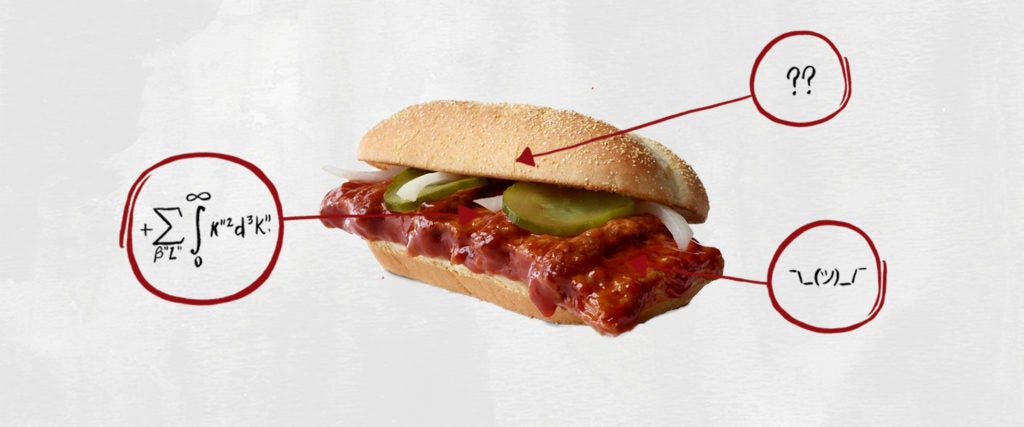We’re often told that you should never eat anything (or put anything on your body) if you don’t recognize everything on the ingredients list. But since most of us have no idea what xanthan gum or potassium benzoate are — or more importantly, what they’re doing to our bodies — we’re decoding the ingredients in the many things Americans put in (and on, or near) themselves.
This edition: McDonald’s McRib, which is made from 28 separate ingredients that we’ve broken down as they appear on their website.
McRib Pork Patty
1) Pork: At conception, in 1981, the McRib patty was believed to be made from restructured meat products like pork heart, tripe and scalded stomach. Nowadays, McDonald’s says the faux ribs are composed primarily of ground pork shoulder. While I can’t speak directly to the quality of McDonald’s meat, in 2012, they pressured their pork supplier to stop using inhumane gestation crates, which is a small step in the right direction.
2) Water: Everyone likes their pork extra wet, right?
3) Salt: In total, a McRib contains 890 milligrams of sodium, or 39 percent of your daily recommended intake. This is a decent amount, especially if you go for fries, too.
4) Dextrose: Dextrose is a sugar derived from starches, like corn, and is chemically identical to glucose, or blood sugar. Fun fact: Dextrose has an especially high glycemic index, meaning it quickly raises blood sugar levels, so it’s used in IV solutions to treat low blood sugar and dehydration. People with diabetes might also consume dextrose tablets to raise their blood sugar levels if they become dangerously low. Because of this blood-sugar-boosting effect, consuming dextrose also provides an almost immediate jolt of energy — and then an inevitable crash.
5) Rosemary Extract: In addition to providing flavor, rosemary extract has natural preservative and antioxidant properties that can slow the deterioration of food.
Homestyle Bun
1) Enriched Flour (Wheat Flour, Malted Barley Flour, Niacin, Reduced Iron, Thiamine Mononitrate, Riboflavin, Folic Acid): As we learned in our exploration of the many, many, many ingredients in the McDonald’s Big Mac, enriched flour is far less “enriched” than the name would have you believe. In addition to containing more calories than whole wheat flour, the bleaching process enriched flour often undergoes produces an unfortunate byproduct: A chemical called alloxan, which has been found to induce diabetes in lab-animal test subjects by destroying their pancreas.
2) Water: More H20.
3) Sugar: A McRib has 13 grams of sugar — more than a serving of Red Hots — which is quite a lot for a sandwich. For reference, the American Heart Association recommends men consume no more than 36 grams and women consume no more than 25 grams of added sugar a day.
4) Yeast: The fungus that makes dough rise.
5) Corn Meal: Ground corn!
6) Salt: More salt.
7) Soybean Oil: According to physician and biochemist Cate Shanahan, consuming too much vegetable oil — which is easy to do, considering Shanahan says roughly 45 percent of the average American’s calories come from refined oils — has serious repercussions (i.e., fatty liver disease, insulin resistance and migraines).
8) Wheat Gluten: Those with celiac disease beware: Wheat gluten is wheat flour that’s been hydrated to activate the gluten, then processed to remove everything but the gluten. It’s added to improve the chewiness of the dough.
9) Mono and Diglycerides: Mono (aka, monoglycerides) and diglycerides are dough conditioners added to improve the texture or quality of dough. They’re often packed with trans fats that aren’t listed on the nutrition facts label, which is incredibly problematic. Because trans fats are associated with an increased risk of heart disease, stroke and diabetes, consuming more than you think you are (because they weren’t listed on the label) could do serious damage to your body.
10) Enzymes: Enzymes simply help dough rise.
11) Ascorbic Acid: Ascorbic acid is just another name for vitamin C, which is used as a preservative.
12) Vinegar: Vinegar adds some tartness and is a common BBQ ingredient.
Pickle Slices
1) Cucumbers: Did y’all know that pickles are made from cucumbers?
2) Water: You should definitely know this one by now.
3) Distilled Vinegar: Vinegar produced from the fermentation of distilled alcohol. The extra acidity it provides helps to penetrate the pickles, enhancing the flavor and acting as a preservative.
4) Salt: Yep, more salt.
5) Calcium Chloride: Calcium chloride helps pickles taste salty without adding even more salt, so it’s really just a means of regulating sodium intake. It’s safe for consumption, according to the FDA.
6) Alum: Alum is a common spice used in pickling recipes to maintain the vegetables’ crispiness.
7) Potassium Sorbate (Preservative): Potassium sorbate prevents yeast and mold growth, and is generally recognized as safe.
8) Natural Flavors: Natural flavors are quite literally flavors derived from an actual food source — i.e., pickle flavoring taken from real pickles.
9) Polysorbate 80: Polysorbate 80 is an emulsifier commonly used in pickling, and it helps disperse the added flavors. Unfortunately, it also promotes inflammatory bowel disease and a cluster of obesity-related diseases known as metabolic syndrome, according to a 2015 study published in the journal Nature. Bummer.
10) Extractives of Turmeric (Color): This is what gives McDonald’s pickles their yellow-ish tint.
Onions
1) Onions: For crunchiness.
The Takeaway
The McRib is far from a farm-to-table pork sammy, and it contains a couple questionable ingredients: Namely, polysorbate 80 and mono and diglycerides. But the bigger problems are the high amounts of sodium, sugar and saturated fat that it delivers, and that’s before fries and a Coke. If that dissuades you from getting your hands on one this time around, don’t worry — it’ll be back.

